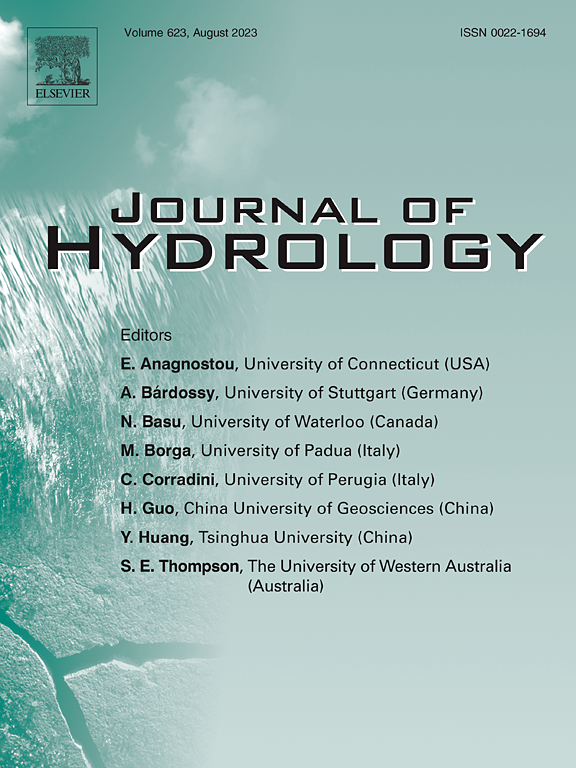GPM IMERG和GSMaP如何推进水文应用:全球视角
IF 5.9
1区 地球科学
Q1 ENGINEERING, CIVIL
引用次数: 0
摘要
作为全球降水测量(GPM)时代的代表性卫星降水产品,最新版本的全球降水综合多卫星反演(IMERG V07)和全球降水卫星制图(GSMaP V08)因其进步而受到全球关注。然而,它们在持续推进全球水文建模和监测方面的潜力和局限性仍未得到充分探索,这对最终用户和算法开发者都至关重要。本研究的目的是:(1)根据全球标准观测和9种广泛使用的降水产品评估IMERG和GSMaP的整体水文性能;(2)研究不同的偏差调整算法对其精度的影响。结果表明:(1)后实时(PRT)和近实时(NRT) IMERG和GSMaP产品均优于TRMM多卫星降水分析(TMPA)产品,其中NRT产品的改进最为显著,特别是在干旱和中高纬度地区;(2) PRT量规修正和NRT偏置调整带来的性能收益在不同产品和地区差异很大。例如,GSMaP严重依赖于基于量规的校正数据集,在观测网络稀疏的地区,其性能下降,校正数据的质量可能会下降。总体而言,增强后的IMERG和GSMaP产品将改善科学研究和业务系统,如全球洪水监测系统(GFMS),以更高的及时性和有效性推进全球水文应用。该研究为这些产品的整体性能提供了有价值的见解,并为改进未来的检索和偏差调整算法提出了方向。本文章由计算机程序翻译,如有差异,请以英文原文为准。
How GPM IMERG and GSMaP advance hydrological applications: A global perspective
As representative satellite precipitation products in the Global Precipitation Measurement (GPM) era, the latest versions of the Integrated Multi-satellitE Retrievals for GPM (IMERG V07) and Global Satellite Mapping of Precipitation (GSMaP V08) have attracted global attention for their advancements. However, their potential and limitations in continued advancing global hydrological modelling and monitoring remain underexplored, which is crucial for both end-users and algorithm developers. This study aims to (1) assess the overall hydrological performance of IMERG and GSMaP against global gauge observations and nine widely used precipitation products, and (2) examine the impact of different bias-adjustment algorithms on their accuracy. The results show that: (1) both post-real-time (PRT) and near-real-time (NRT) IMERG and GSMaP products outperform their predecessor, the TRMM Multi-Satellite Precipitation Analysis (TMPA), with the most significant improvements in NRT products, particularly in arid and mid-to-high latitude regions; (2) performance gains from PRT gauge corrections and NRT bias adjustments varies considerably across products and regions. For instance, GSMaP relies heavily on the gauge-based correction dataset, and its performance declines in areas with sparse observation networks where the quality of correction data may degrade. Overall, the enhanced IMERG and GSMaP products are poised to improve both scientific research and operational systems, such as the Global Flood Monitoring System (GFMS), advancing global hydrological applications with greater timeliness and efficacy. This study provides valuable insights into the global performance of these products and suggests directions for improving future retrieval and bias-adjustment algorithms.
求助全文
通过发布文献求助,成功后即可免费获取论文全文。
去求助
来源期刊

Journal of Hydrology
地学-地球科学综合
CiteScore
11.00
自引率
12.50%
发文量
1309
审稿时长
7.5 months
期刊介绍:
The Journal of Hydrology publishes original research papers and comprehensive reviews in all the subfields of the hydrological sciences including water based management and policy issues that impact on economics and society. These comprise, but are not limited to the physical, chemical, biogeochemical, stochastic and systems aspects of surface and groundwater hydrology, hydrometeorology and hydrogeology. Relevant topics incorporating the insights and methodologies of disciplines such as climatology, water resource systems, hydraulics, agrohydrology, geomorphology, soil science, instrumentation and remote sensing, civil and environmental engineering are included. Social science perspectives on hydrological problems such as resource and ecological economics, environmental sociology, psychology and behavioural science, management and policy analysis are also invited. Multi-and interdisciplinary analyses of hydrological problems are within scope. The science published in the Journal of Hydrology is relevant to catchment scales rather than exclusively to a local scale or site.
 求助内容:
求助内容: 应助结果提醒方式:
应助结果提醒方式:


